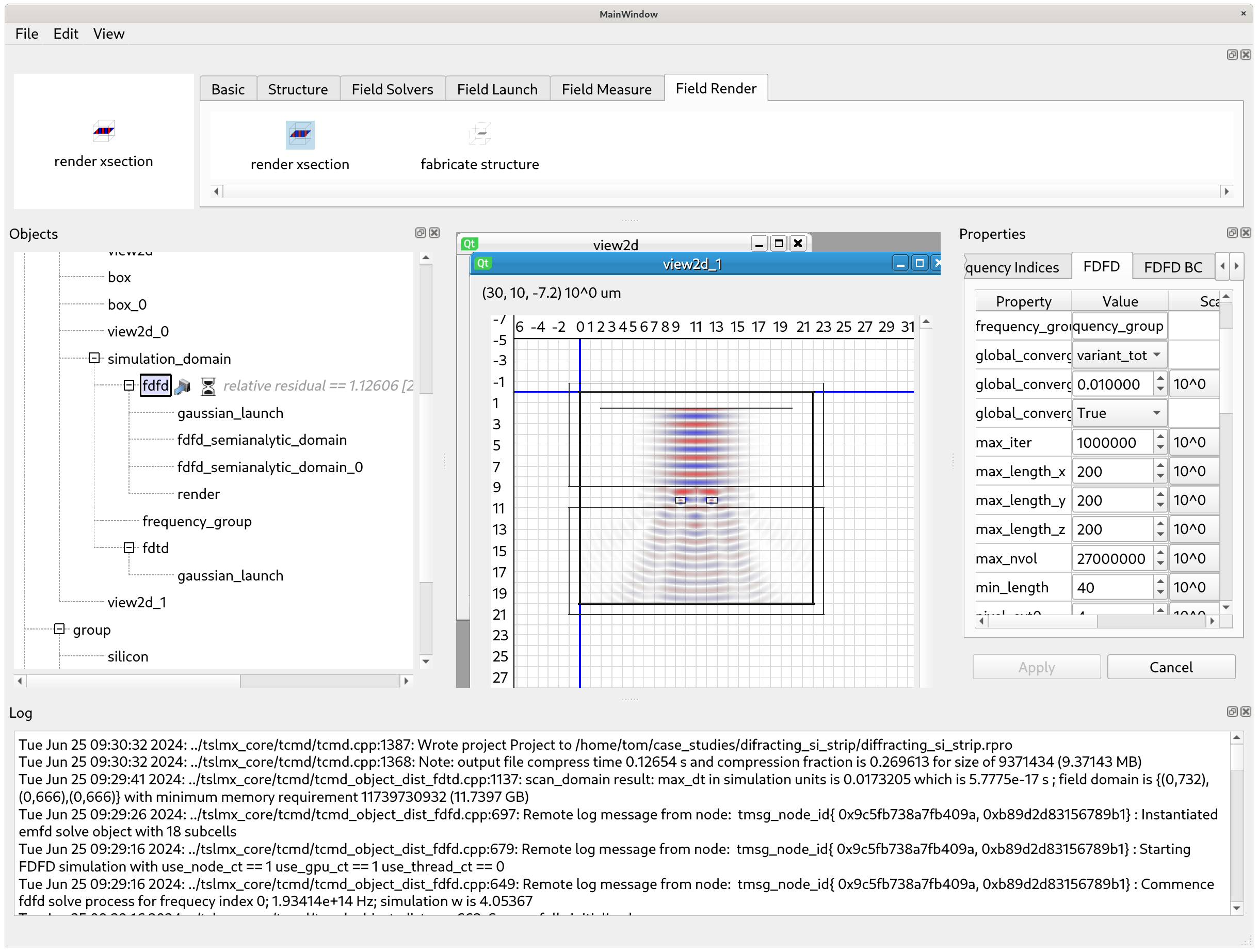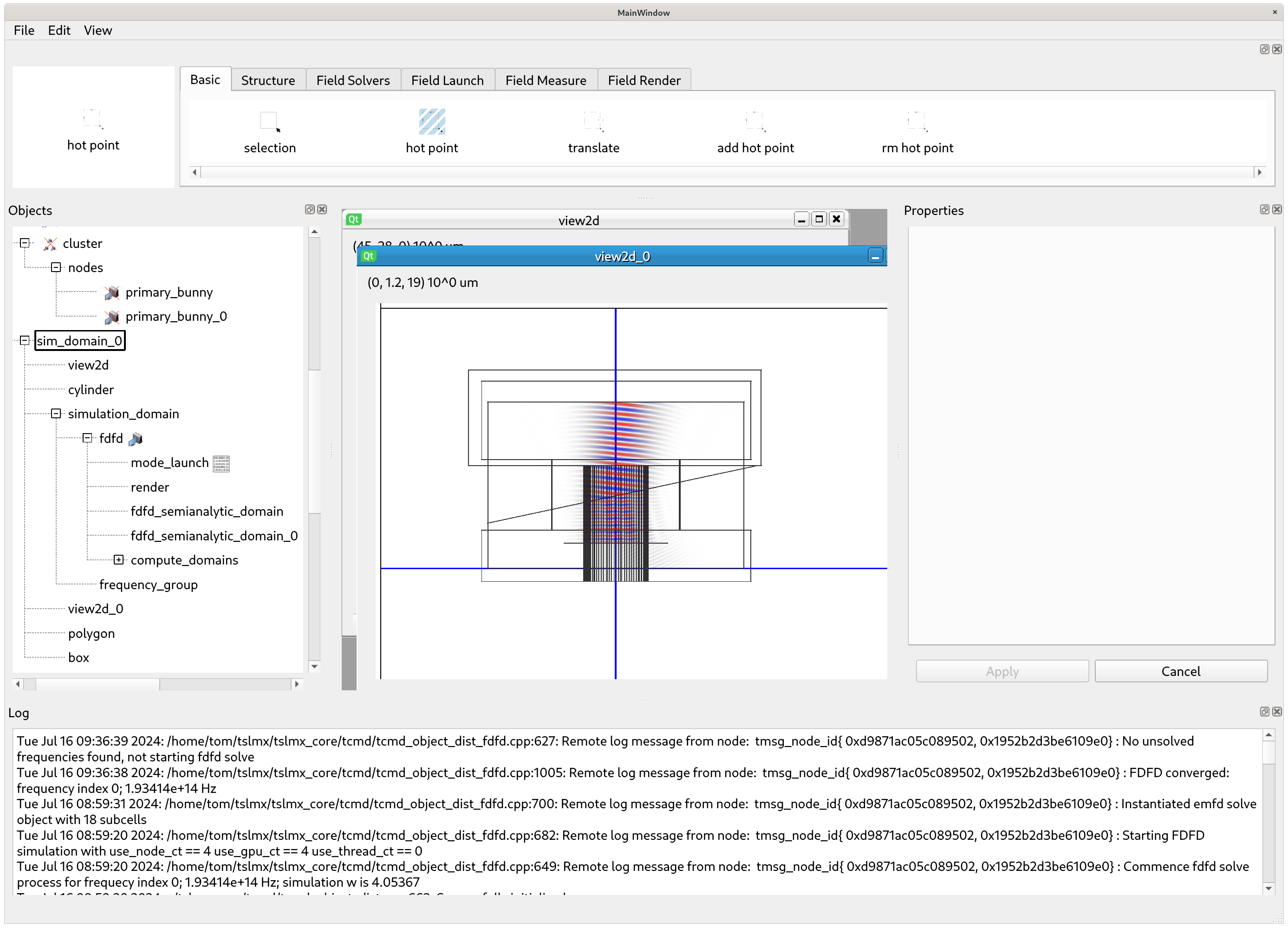Tesselmax.EM
Tesselmax.EM is a finite-difference time domain (FDTD) and finite-difference frequency domain (FDFD) software solution. A mode solver is also included. All calculations are based on a Cartesian mesh, in which the discretization can be varied in each dimension independently.
Please see our product brochure
All simulations can be controlled from a GUI which includes a CAD system for building structures and simulations. It is possible to import structures from GDS2 files. There's a Python interface for seamless scripting, with a built-in Python engine within the GUI environment, as well as the capability for an external Python process to interface with the software and drive all operations from script files.
Tesselmax.EM is designed to be both cloud- and GPU-ready. Specifically, the FDTD, FDFD and modesolve algorithms will run on CUDA enabled GPUs. DGX-A100 and H100 boxes are supported, and we've tested configurations with up to 8 GPUs and obtained good scaling. It's also possible to run on CPUs. You can run the algorithms on clusters of machines, though FDTD on GPU will not scale well on normal (1 Gbps) Ethernet due to the incredible speed of single-GPU FDTD. Good scaling will be seen for CPUs, but we recommend that all users utilize GPUs if possible since the relative speedup is immense, often exceeding 10x on current generation GPUs. This unprecedented power makes it possible to use FDTD to attack problems that were heretofore very difficult to address, such as simulations of fiber endfacets or other structures that could be 10s of um in dimension on each side.
Please note: recommended usage for large FDTD simulations is to run the GUI locally on your local machine, often windows or Mac, while the computation runs on a remote cloud machine, often Linux. You should not need to use VNC or run the GUI through X windows. We also highly recommend Nvidia GPUs, they outperform CPUs by a huge amount.
Example: Y-junction simulation
Y-junction simulation; one of our tutorials shows a y-junction simulation in which we match Tesselmax.EM's results to the published literature
Tesselmax.EM Alpha is Live!
Tesselmax.EM Alpha is now live as of March 26 2025. The alpha license is completely free to use. Please note that the FDFD solver is still not fully debugged and won't work well, especially on cloud nodes. You can give it a try to see what we'll eventually have, but usually it's not going to be fast enough to be competitive with FDTD. The modesolver and FDTD solvers, however, should be ready for use in even the most challenging situations. We're excited to hear what users think of what we have so far. Please note the alpha license is completely free.
Pricing
We will move to a non-free model within around a year. We will provide a 3 month notification prior to making this transition. We are still finalizing pricing. However, the current target is as follows:
- A full commercial version, with 1 GUI node and 8 compute nodes (supporting up to and including a complete 8x GPU DGX-A100 box for example) will be $2000 USD/year.
- Commercial GUI nodes can be purchased for $500/year.
- Supercomputing version with 2 GUI nodes 64 compute nodes is $10,000 USD/year.
- A student/non-commercial version, for non-commercial use by students and research staff only, and with 1 GUI node and 8 compute nodes and missing a few commercial grade features will be $50 USD/year.
- There will be a 30 day free trial for both student and commercial licenses.
We reserve the right to change pricing at the time and in following years depending on market conditions and other factors. But, these are our pricing goals.
Cloud Providers
Advancements in AI have led to machines of incredible power and multiple CPU / GPU configurations becoming available. Below is a list of some of the cloud providers that are known to offer instances compatible with our software. You can run the software on your local computer of course, and if you have an Nvidia GPU performance may be acceptable for even large 3d simulations. But using multi-GPU DGX boxes in the cloud will bring the simulation speeds to very high levels.
Target Regime Of Simulation
Our simulations are primarily aimed at the integrated photonics market, specifically for situations involving radiation wavelength within the ranges from ~500 nm - 5 um and feature sizes are on the order of 100 nm - 10 um, but, these are not fixed boundaries. Tesselmax.EM supports imperfect and perfect metals, frequency dependent materials, anisotropic materials, and more. Essentially any linear media should be simulatable with either FDTD or FDFD.
It will be possible to simulate RF with our tool in some situations. However, in our view FDTD and FDFD generally are not the right algorithms for this regime. In many cases, RF simulations involve very small feature sizes relative to wavelengths, which does not lend itself well to FDTD or FDFD. These methods typically suffer from long runtimes or convergence difficulties due to the required fine discretization. Finite-element is often a better choice for such simulations. We are, however, eager to hear feedback from our users on this topic.
Cross-platform Availability
Our software will run on Mac arm64 or x86_64, Windows arm64 or x86_64, and Linux arm64 or x86_64. CUDA is supported on Windows x86_64, and Linux x86_64 and arm64. It has also been tested on a number of high-power cloud configurations such as DGX-A100 and DGX-H100. It has been tested on RHEL 8 and 9 and Ubuntu 22.04 and 24.04. It will probably work on other Linux distros as well, but support for other Linux distros is not guaranteed. That being said, if there's demand for support on a particular platform, we can probably add it.
Easy To Deploy
We've used a proprietary messaging system that is designed to make it easier to deploy our software. Tesselmax.EM will run on most platforms with minimal or no installation of additional libraries. In fact, our software is so easy to deploy that we don't even include an installation program; you can simply run the binary in most situations. In almost all use cases, there's no need for a cluster configuration file or any other complicated configuration. Simply run a command and a machine is "assimilated" into a cluster which is then controllable from the GUI or from Python.
Internet-ready With Encryption
We use encryption technologies with robust, widely-used algorithms. This lets you run our software directly over the internet without the need for a VPN or any other protection. You may choose to use a VPN for an optional additional layer of security or convenience; our software has been tested with the Tailscale VPN.
Ready For Use In All Situations
Running a large simulation on the cloud from an airport and suddenly the connection drops? No problem. In most cases, the simulation will keep running, and you can reconnect.



